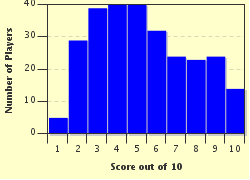Quiz Answer Key and Fun Facts
1. I have a chess board with eight rows and eight columns, and I have 32 dominoes which happen to fit quite nicely on my board. If I cut off two opposing corners of the board, would I be able to cover it completely with 31 dominoes?
2. 153 may look a rather ordinary number, but it has some unusual properties. It is one of only six numbers that is the sum of the cubes of its digits- (1^3)+(5^3)+(3^3) = 1 + 125 + 27 = 153. There are only three higher numbers that share this trick- what is the next in the series?
3. Some numbers appear the same upside-down (0,1,8) and one pair, (6,9) become each other when flipped. Armed with these stunning revelations, what was the last year that appears the same both upside-down and right side up?
4. Magic squares have fascinated scholars for centuries. A magic square is a square grid with columns, rows and diagonals all having the same total when summed. The simplest one is a 3x3 square containing the digits 1-9. The square shown is NOT correct as there are differing totals, but what will each row and column add up to in a properly constructed 1-9 square?
5. What fiery number is represented by the seven Roman numerals, arranged from highest to lowest?
6. A series of bridges in the German city of Königsberg spawned a branch of mathematics in the eighteenth century. If you cannot tell the difference between a doughnut and a coffee mug, this should be your area of expertise. What branch of maths am I talking about?
7. This is a well-known 'proof' that 2=1.
Let x = y.
1) Multiply both sides by x
x^2 = xy
2) Subtract y^2 from both sides
x^2 - y^2 = xy - y^2.
3) Factorise
(x+y)(x-y) = y(x-y)
4) Divide both sides by (x-y)
x + y = y.
5) Since x = y, we see that
2y = y
6) Divide by y, and we can see that
2 = 1
Obviously, there is a flaw in the calculating, but where? Which step is the wrong one?
8. Tessellations are quite attractive patterns, where each shape, or cell, fits together, with no spaces or overlaps. Only three regular geometric shapes will tessellate properly, but which of these shapes will NOT fit together with tiles of equal shape?
9. The Fibonacci series is a fascinating collection of numbers. What irrational constant is approached when you divide one Fibonacci number by its predecessor? (ie, 2/1, 3/2, 5/3,...144/89, ...F(n)/F(n-1)...)
10. There is only one prime number that is the sum of four consecutive prime numbers. Can you figure out what number it is?
Source: Author
ozzz2002
This quiz was reviewed by FunTrivia editor
rossian before going online.
Any errors found in FunTrivia content are routinely corrected through our feedback system.

